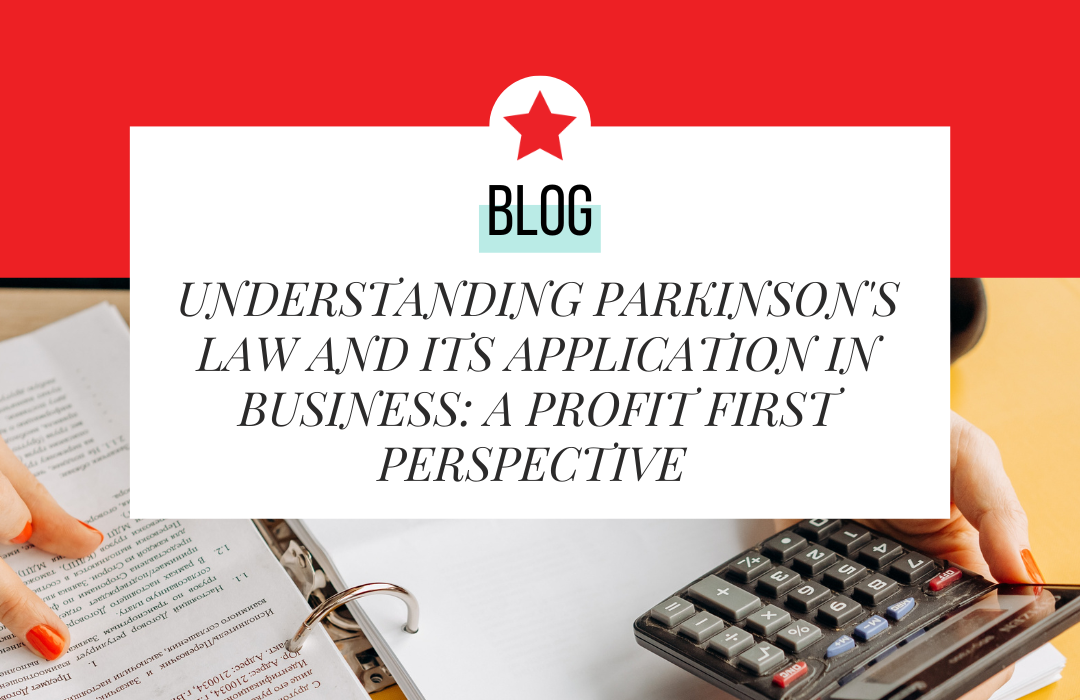[et_pb_section fb_built=”1″ _builder_version=”4.13.0″ _module_preset=”default” custom_padding=”8px|||||” global_colors_info=”{}”][et_pb_row _builder_version=”4.13.0″ _module_preset=”default” global_colors_info=”{}”][et_pb_column type=”4_4″ _builder_version=”4.13.0″ _module_preset=”default” global_colors_info=”{}”][et_pb_text _builder_version=”4.13.0″ _module_preset=”default” global_colors_info=”{}”]
Understanding Parkinson’s Law and Its Application in Business: A Profit First Perspective
In the realm of business management and personal productivity, Parkinson’s Law emerges as a pivotal concept that can significantly impact how we approach tasks and manage our resources. The law states, “Work expands so as to fill the time available for its completion.” This seemingly simple statement holds profound implications for businesses and individuals alike, especially when viewed through the lens of the Profit First methodology.
The Essence of Parkinson’s Law
Parkinson’s Law, first articulated by Cyril Northcote Parkinson in 1955, highlights a human tendency to stretch a task to fill the time allotted for it. For instance, if you have a week to complete a project, it will likely take a week, even if it could be done in a day. This behavior is not just about procrastination but also about the inefficiencies that creep in when there is an abundance of time or resources.
Tying it Back to Profit First
In the context of Profit First, a revolutionary approach to business finance management, Parkinson’s Law can be a game-changer. Profit First, championed by Mike Michalowicz, flips the traditional accounting formula of Sales – Expenses = Profit to Sales – Profit = Expenses. This shift encourages businesses to prioritize profit and operate within the means of the remaining resources.
Applying Parkinson’s Law to this formula, we understand that a business’s expenses will expand to consume the available funds unless profit is taken out first. By limiting the available funds for expenses, businesses are compelled to operate more efficiently, cutting unnecessary costs and fostering a culture of resourcefulness.
Illustrative Examples of Parkinson’s Law
- Budgeting in a Restaurant: In a restaurant, if there is a set budget, such as a food cost percentage set aside for food purchases for the week, the purchasing decisions will be more calculated, reducing waste and unnecessary purchases. This mirrors the Profit First approach, where limits drive efficiency.
- Project Deadlines in Construction: In construction, if a project is given a six-month deadline, it will likely take six months, even if it could be completed sooner. By shortening the timeline, the team becomes more focused and efficient, similar to how restricting available funds for expenses forces a business to be more profitable.
- Inventory Management in Retail: Retail stores that limit their inventory space must select their products more judiciously, which can lead to a more curated and profitable selection, echoing the principles of Profit First.
Conclusion
Parkinson’s Law, when applied to business, especially in tandem with the Profit First methodology, can be a very powerful tool. It teaches us that constraints, whether in time or resources, can lead to increased efficiency and productivity. By embracing this law, businesses can not only optimize their operations but also ensure that profitability is at the forefront of their financial planning. As we continue to navigate the complexities of business management, understanding and applying Parkinson’s Law can be a key to achieving sustained success and growth.
[/et_pb_text][/et_pb_column][/et_pb_row][et_pb_row _builder_version=”4.13.0″ _module_preset=”default” global_colors_info=”{}”][et_pb_column type=”4_4″ _builder_version=”4.13.0″ _module_preset=”default” global_colors_info=”{}”][et_pb_code _builder_version=”4.13.0″ _module_preset=”default” global_colors_info=”{}”]
[/et_pb_code][/et_pb_column][/et_pb_row][et_pb_row _builder_version=”4.13.0″ _module_preset=”default” global_colors_info=”{}”][et_pb_column type=”4_4″ _builder_version=”4.13.0″ _module_preset=”default” global_colors_info=”{}”][et_pb_post_slider include_categories=”current” show_more_button=”off” use_manual_excerpt=”off” excerpt_length=”0″ show_meta=”off” show_image=”off” _builder_version=”4.13.0″ _module_preset=”default” header_font=”|600|||||||” header_text_color=”#FFFFFF” background_color=”#38459C” filter_brightness=”146%” global_colors_info=”{}”][/et_pb_post_slider][/et_pb_column][/et_pb_row][et_pb_row column_structure=”1_2,1_2″ _builder_version=”4.13.0″ _module_preset=”default” global_colors_info=”{}”][et_pb_column type=”1_2″ _builder_version=”4.13.0″ _module_preset=”default” global_colors_info=”{}”][et_pb_image src=”https://sparkbusinessconsulting.com/wp-content/uploads/2023/11/1128-Pin-Blog-Template-1.png” title_text=”1128 Pin Blog Template – #1″ _builder_version=”4.13.0″ _module_preset=”default” global_colors_info=”{}”][/et_pb_image][/et_pb_column][et_pb_column type=”1_2″ _builder_version=”4.13.0″ _module_preset=”default” global_colors_info=”{}”][et_pb_image src=”https://sparkbusinessconsulting.com/wp-content/uploads/2023/11/1128-PIN-Quote-White.png” title_text=”11:28 PIN Quote-White” _builder_version=”4.13.0″ _module_preset=”default” global_colors_info=”{}”][/et_pb_image][/et_pb_column][/et_pb_row][/et_pb_section]









